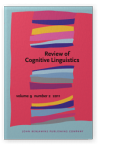van de Weijer, Joost, Ivana Bianchi & Carita Paradis
2024.
Sensory modality profiles of antonyms.
Language and Cognition 16:1
► pp. 93 ff.

Bekhta, Ivan, Olesya Tatarovska & Oksana Melnychuk
2023.
RETRACTED CHAPTER: Negation and Mental Images. In
Proceedings of the Future Technologies Conference (FTC) 2023, Volume 3 [
Lecture Notes in Networks and Systems, 815],
► pp. 373 ff.

Caballero, Rosario & Carita Paradis
2023.
Sharing Perceptual Experiences through Language.
Journal of Intelligence 11:7
► pp. 129 ff.

Bianchi, Ivana, Hang Truong, Alex M. T. Russell & Roberto Burro
2022.
Testing Australian standard consumers' understanding of the language used to describe wine.
Journal of Sensory Studies 37:4

Bianchi, Ivana, Erika Branchini, Stefania Torquati, Arianna Fermani, Elena Capitani, Veronica Barnaba, Ugo Savardi & Roberto Burro
2021.
Non experts’ understanding of terms frequently used by experts to describe the sensory properties of wine: An investigation based on opposites.
Food Quality and Preference 92
► pp. 104215 ff.

PÕLDVERE, NELE, VICTORIA JOHANSSON & CARITA PARADIS
2021.
Resonance in dialogue: the interplay between intersubjective motivations and cognitive facilitation.
Language and Cognition 13:4
► pp. 643 ff.

PÕLDVERE, NELE & CARITA PARADIS
2020.
‘What and then a little robot brings it to you?’ The reactivewhat-xconstruction in spoken dialogue.
English Language and Linguistics 24:2
► pp. 307 ff.

Farshchi, Sara, Richard Andersson, Joost van de Weijer & Carita Paradis
2019.
Processing Negation in a Miniature Artificial Language.
Cognitive Science 43:3

Hartman, Jenny & Carita Paradis
2018.
Emotive and sensory simulation through comparative construal.
Metaphor and Symbol 33:2
► pp. 123 ff.

Hartman, Jenny & Carita Paradis
2023.
The language of sound: events and meaning multitasking of words.
Cognitive Linguistics 34:3-4
► pp. 445 ff.

Hassanein, Hamada
2018.
Discourse functions of opposition in Classical Arabic: The case in Ḥadīth Genre.
Lingua 201
► pp. 18 ff.

Kraska-Szlenk, Iwona
2018.
Address inversion in Swahili: Usage patterns, cognitive motivation and cultural factors.
Cognitive Linguistics 29:3
► pp. 545 ff.

Schietecat, Anne C., Daniël Lakens, Wijnand A. IJsselsteijn, Yvonne A. W. de Kort, Nathan Van der Stoep & Rolf Zwaan
2018.
Predicting Context-Dependent Cross-Modal Associations with Dimension-Specific Polarity Attributions Part 1 – Brightness and Aggression.
Collabra: Psychology 4:1

Schietecat, Anne C., Daniël Lakens, Wijnand A. IJsselsteijn, Yvonne A. W. de Kort, Rolf Zwaan & Nathan Van der Stoep
2018.
Predicting Context-dependent Cross-modal Associations with Dimension-specific Polarity Attributions. Part 2: Red and Valence.
Collabra: Psychology 4:1

Bianchi, Ivana, Carita Paradis, Roberto Burro, Joost van de Weijer, Marcus Nyström & Ugo Savardi
2017.
Identification of opposites and intermediates by eye and by hand.
Acta Psychologica 180
► pp. 175 ff.

HARTMAN, JENNY
2018.
Constructions of contrast in spoken testimonials on Obsessive Compulsive Disorder.
Language and Cognition 10:1
► pp. 83 ff.

Keller, Joshua, Jeffrey Loewenstein & Jin Yan
2017.
Culture, Conditions and Paradoxical Frames.
Organization Studies 38:3-4
► pp. 539 ff.

KOSKELA, ANU
2017.
Coatsandbrasandjeans– andclothes, too: lexical contrast between hyperonyms and hyponyms.
English Language and Linguistics 21:3
► pp. 475 ff.

Simaki, Vasiliki, Carita Paradis, Maria Skeppstedt, Magnus Sahlgren, Kostiantyn Kucher & Andreas Kerren
2017.
Annotating Speaker Stance in Discourse: The Brexit Blog Corpus.
Corpus Linguistics and Linguistic Theory 0:0

Tzeng, Christina Y., Lynne C. Nygaard & Laura L. Namy
2017.
The Specificity of Sound Symbolic Correspondences in Spoken Language.
Cognitive Science 41:8
► pp. 2191 ff.

Wallin, Annika, Carita Paradis & Konstantinos V. Katsikopoulos
2016.
Evaluative polarity words in risky choice framing.
Journal of Pragmatics 106
► pp. 20 ff.

Branchini, Erika, Roberto Burro, Ivana Bianchi & Ugo Savardi
2015.
Contraries as an effective strategy in geometrical problem solving.
Thinking & Reasoning 21:4
► pp. 397 ff.

Cacciari, Cristina, Francesca Pesciarelli, Tania Gamberoni, Fabio Ferlazzo, Leo Russo, Francesca Pedrazzi & Ermanno Melati
2015.
Is Black Always the Opposite of White? An Investigation on the Comprehension of Antonyms in People with Schizophrenia and in Healthy Participants.
Behavioral Sciences 5:1
► pp. 93 ff.

Dessalles, Jean-Louis
2015.
From Conceptual Spaces to Predicates. In
Applications of Conceptual Spaces [
Synthese Library, 359],
► pp. 17 ff.

Widhiarso, Wahyu & Haryanta
2015.
Examining Method Effect of Synonym and Antonym Test in Verbal Abilities Measure.
Europe’s Journal of Psychology 11:3
► pp. 419 ff.

Fuoli, Matteo & Carita Paradis
2014.
A model of trust-repair discourse.
Journal of Pragmatics 74
► pp. 52 ff.

van de Weijer, Joost, Carita Paradis, Caroline Willners & Magnus Lindgren
2014.
Antonym canonicity: Temporal and contextual manipulations.
Brain and Language 128:1
► pp. 1 ff.

Bianchi, Ivana, Roberto Burro, Stefania Torquati & Ugo Savardi
2013.
The middle of the road: Perceiving intermediates.
Acta Psychologica 144:1
► pp. 121 ff.

Paradis, Carita
2012.
Lexical Semantics. In
The Encyclopedia of Applied Linguistics,

Paradis, Carita
2015.
Conceptual Spaces at Work in Sensory Cognition: Domains, Dimensions and Distances. In
Applications of Conceptual Spaces [
Synthese Library, 359],
► pp. 33 ff.

Paradis, Carita
2024.
Lexical Semantics. In
The Encyclopedia of Applied Linguistics,
► pp. 1 ff.

This list is based on CrossRef data as of 16 july 2024. Please note that it may not be complete. Sources presented here have been supplied by the respective publishers.
Any errors therein should be reported to them.
